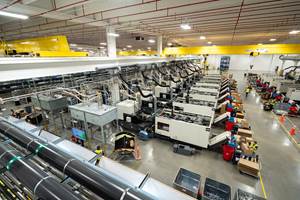Nonlinear Modelling: A Proven Mathematical Tool for Efficient Product Development
This approach been shown to be beneficial to crosslinked foam producers and applicable to other types of plastics processors.
A mathematical tool that proved to be an effective approach to save time, money and effort in product development for foam extruders, can also be used by various types of plastics processors.This was recently brought to our attention by Abhay Bulsari, owner and president of a Finland-based 22-year-old process and materials development consultancy called Nonlinear Solutions Oy. Here, Bulsari gives us the example applying linear modelling in his work with Finnish PE foam extruder NMC Termonova.
Bulsari’s goal was to help speed up the company’s product development, which included not only improving the quality of its foamed products, but also how to produce better recipes and new products with more demanding combinations of material properties. Explains Bulsari, “We have established how nonlinear models are a powerful tool for materials development as they can contain valuable knowledge in a concise and precise form. A small number of experiments suffices for the development of nonlinear models, if planned suitably. Material properties can be related with the composition variables, process variables and dimension variables effectively using nonlinear modeling.”
NMC Termonova produces crosslinked, foamed LPDE products using the Furukawa process, according to Markku Talja senior production chemist. The raw LDPE polymer is mixed with a crosslinking agent and a blowing agent and fed to an extruder which produces a thin and wide sheet—or, a matrix. It is then fed to an oven, where it is crosslinked and foamed. The foam is then cooled with water and wound into rolls.
Keep the ‘Wider Picture’ in Mind & Apply Nonlinear Modeling
Among the key applications of foamed plastics is thermal insulation. Like material properties of various kinds of materials, thermal conductivity also depends on the composition variables, process variables and dimension variables, explains Bulsari. “Since one material property often comes at the cost of another, and could affect the production economics, it is desirable to keep the wider picture in mind, which includes several consequences of operating the process. Once we know quantitatively how these variables affect the various consequences, we can determine good or optimal values of those compositions, process and dimension variables to achieve a desired combination of product properties, production rate and production cost.”
The relation between these variables is usually not expected to be very simple or linear. Mathematical models can be used instead of experimentation if they are sufficiently reliable. They can be used to improve quality, make changes in processing, as well as determine ways to produce new products with desired combinations of product properties, or with lower costs. Says Bulsari, “Mathematical modeling can be carried out in different ways and the different approaches are suitable in different situations. However, conventional techniques of empirical modeling are linear. Nothing in nature is very linear, and materials science is full of nonlinearities.”
In contrast, it has been established that feed-forward neural networks—a kind of mathematical modeling approach and more recently a part of artificial intelligence—now increasingly used by R&D people, do not require the knowledge of the type of the nonlinearities in advance. “They are attractive for nonlinear modelling because of their universal approximation capabilities which make them very suitable for most function approximation tasks we come across in materials science and process engineering. The user does not need to know the type and severity of nonlinearities while developing the model,” explains Bulsari. There are many different types of neural networks, and the multilayer perceptron, a kind of feed-forward neural network, is the most common one. They have been in use for over 20 years and have benefited process industries including plastics, composites, rubbers, and chemicals.
Product properties including thermal conductivity depend on the amount of polymer, blowing agent, crosslinking agent, etc. Prior to conducting well-planned experiments and developing nonlinear models, NMC Termonova would conduct trial-and-error experiments when they saw a need to improve something. This is a common approach for many plastic processors, but is fairly inefficient. It requires a lot of experimentation, and the final result may not be very good, according to Bulsari.
Working with this foam extruder, Bulsari developed neural network models for several material properties like thermal conductivity, density, slab thickness, tensile strength, and also for production economic variables, from 38 experiments carried out for this project. It was shown that with appropriate mathematical tools, such models can be used to determine ways to produce foam with desired values of thermal conductivity in combination with limits on strength, density, etc. “If the combination is impossible with the raw materials in use, we would know it very quickly without spending a lot of time and effort in experimentation. We are able to use the same models also to determine ways to reduce production costs,” says Bulsari.
In conclusion, he confirms that he worked with several of NMC Termonova’s existing recipes and using the nonlinear models calculated new recipes for the same products, all of each are lower in cost by at least a few percent.
Related Content
LyondellBasell Showcasing End-Use Applications in 5 Key Markets
NPE2024: LYB is highlighting applications in circularity, mobility and transportation, food and medical, consumer goods/lifestyle, and infrastructure/building and construction.
Read MoreEV Chargers Made From Renewable PC
SABIC is enabling Charge Amps to manufacture electric vehicle (EV) chargers with a housing made from certified renewable PC, a first for the industry.
Read MoreIPEX Opens Injection Molding Facility in North Carolina
The pipe and fittings manufacturer’s new 200,000-square-foot facility represents a $200 million investment and will create 150 jobs.
Read MoreInfrastructure May Prove Big Landing Spot for Recycled Plastics
As the government funds infrastructure improvements, a hot topic at NPE2024 – exploration of the role recycled plastics can play in upcoming projects, particularly road development.
Read MoreRead Next
People 4.0 – How to Get Buy-In from Your Staff for Industry 4.0 Systems
Implementing a production monitoring system as the foundation of a ‘smart factory’ is about integrating people with new technology as much as it is about integrating machines and computers. Here are tips from a company that has gone through the process.
Read MoreFor PLASTICS' CEO Seaholm, NPE to Shine Light on Sustainability Successes
With advocacy, communication and sustainability as three main pillars, Seaholm leads a trade association to NPE that ‘is more active today than we have ever been.’
Read MoreMaking the Circular Economy a Reality
Driven by brand owner demands and new worldwide legislation, the entire supply chain is working toward the shift to circularity, with some evidence the circular economy has already begun.
Read More














